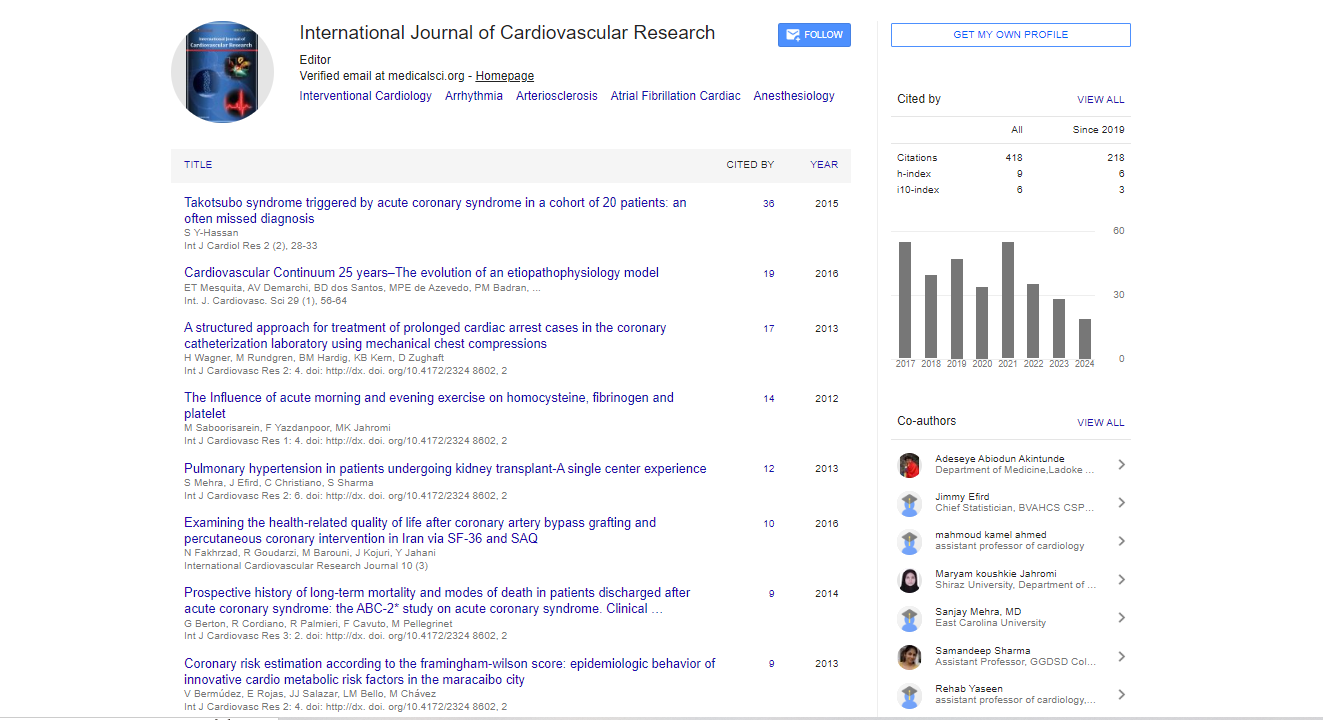Research Article, Int J Cardiovasc Res Vol: 4 Issue: 2
Oral Propranolol: A Corner Stone in the Therapeutic Strategy of Infantile Haemangiomas
| Hany M Abo-Haded1, Ahmed A Khalil2 and Abeer Fathy3* | |
| 1Pediatric Cardiology Unit, Department of Pediatrics, Faculty of Medicine, Mansoura University, Mansoura, Egypt | |
| 2Department of plastic surgery, Faculty of Medicine, Mansoura University, Mansoura, Egypt | |
| 3Gasrtoenterology and Hepatology Unit, Department of Pediatrics, Faculty of Medicine, Mansoura University, Mansoura, Egypt | |
| Corresponding author : Abeer Fathy, MD MHS Department of Pediatrics, Faculty of Medicine, Mansoura University, Mansoura, 35516, Egypt Tel: + 002 01020579852 E-mail: abeerfathy2000@yahoo.com |
|
| Received: February 15, 2015 Accepted: February 27, 2015 Published: March 02, 2015 | |
| Citation: Fathy A, Haded HMA, Khalil AA (2015) Oral Propranolol: A Corner Stone in the Therapeutic Strategy of Infantile Haemangiomas. Int J Cardiovasc Res 4:2. doi:10.4172/2324-8602.1000202 |
Abstract
Oral Propranolol: A Corner Stone in the Therapeutic Strategy of Infantile Haemangiomas
Infantile hemangiomas are the most common tumors of childhood. Despite their benign and self-limited nature, some hemangiomas can cause complications such as ulceration or life-altering disfigurement. In addition, they may compromise vital organ function, or herald underlying developmental anomalies of the central nervous system or spine [1]. Until recently, high-dose steroid therapy was the mainstay treatment for problematic proliferating infantile hemangioma [2]. Whilst corticosteroids are effective, they are associated with significant adverse effects as cushing syndrome, growth retardation, hirsutism, hypertension, and immunosuppression [3]. Interferon alpha is a potent inhibitor of angiogenesis that can be used in the treatment of infantile hemangiomas [4]. However, its reported severe neurotoxicity, including spastic diplegia, limits its use to cases with life-threatening hemangiomas that have not responded to other forms of treatment [5]. Vincristine was initially used in the treatment of the Kasabach-Merritt phenomenon [6]. Moreover,it is used as an alternative therapy for glucocorticoid-unresponsive, lifethreatening, or severely life-altering hemangiomas[7]. Pulsed dye laser therapyis another treatment option that was found to be beneficial for select infantile hemangiomas including those with small superficial, ulcerated, or involuting lesions [8,9]. In 2008, a French group accidently observed accelerated involution of large facial hemangiomas in two infants following treatment with propranolol for heart failure [10]. These favorable results led to the initiation of some case reports and observational studies to evaluate the efficacy of propranolol in the treatment of proliferating infantile hemangioma [11-14]. To date, the mechanism of action of propranolol on infantile hemangioma is not clear [15]. Moreover, there are some concerns about the potential complications with propranolol usage. The most frequently reported serious side effects were asymptomatic hypotension, asymptomatic bradycardia[16], pulmonary symptoms related to blockade of adrenergic bronchodilation [17], hypoglycemia [17], and hyperkalemia [18]. The most commonly reported non potentially life-threatening side effects were sleep disturbances including nightmares, somnolence, cool or mottled extremities, diarrhea, and gastroesophageal reflux/upset [19]. .
 Spanish
Spanish  Chinese
Chinese  Russian
Russian  German
German  French
French  Japanese
Japanese  Portuguese
Portuguese  Hindi
Hindi 



